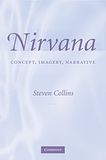Nirvana
Collins, Steven:
Nirvāṇa : Concept, Imagery, Narrative / Steven Collins. - Cambridge : Cambridge University Press, 2010. - ca. 204 S.
ISBN 978-0-521-70834-0
£ 16,99 (Paperback)
ISBN 978-0-521-88198-2
£ 40,00 (Hardcover)
DDC: 294.3423
-- Angekündigt für März 2010 --
Beschreibung
The idea of nirvana (Pali nibbāna) is alluring but elusive for non-specialists and specialists alike. Offering his own interpretation of key texts, Steven Collins explains the idea in a new, accessible way - as a concept, as an image (metaphor), and as an element in the process of narrating both linear and cyclical time. Exploring nirvana from literary and philosophical perspectives, he argues that it has a specific role: to provide ‘the sense of an ending’ in both the systematic and the narrative thought of the Pali imaginaire. Translations from a number of texts, including some dealing with past and future Buddhas, enable the reader to access source material directly. This book will be essential reading for students of Buddhism, but will also have much to teach anyone concerned with Asia and its religions, or indeed anyone with an interest in the ideas of eternal life or timelessness. [Verlagsinformation]
Autor

STEVEN COLLINS is Chester D. Tripp Professor in the Humanities at the University of Chicago. He is the author of Nirvana and Other Buddhist Felicities: Utopias of the Pali Imaginaire (Cambridge, 1998). Faculty profile.
Quellen: Cambridge University Press; Amazon; WorldCat
Ähnlich
- Therigatha
- Franco/Notake: Dharmakīrti on the Duality of the Object
- Moriyama: Omniscience and Religious Authority
- Women in Early Indian Buddhism
- Buddhism and Law
- Rakow: Transformationen des tibetischen Buddhismus
- De Chiara: The Khotanese Sudhanāvadāna ... 2
- Tiso: Liberation in One Lifetime
- Sthiramati's Pañcaskandhakavibhāṣā
- Helman-Ważny: Archaeology of Tibetan Books

